Page 299 of 416
299 Practical hints
What to do if …?
Display
Possible cause
Suggested solution
AIR FILTER
CHANGE CARTRIDGE
VISIT WORKSHOP!
The air filter is clogged.
�
Have the air filter checked by an au-
thorized Mercedes-Benz Center.
@
AIRMATIC
STOP, CAR TOO LOW!
The vehicle is parked on an extremely
uneven surface.
�
Press the vehicle level control button
to select the raised vehicle level
(�page 212).
The vehicle level control is malfunctioning.
�
Stop and press the vehicle level con-
trol button to select a higher vehicle
level (
�page 212).
�
Do not turn steering wheel too far to
avoid damaging the front fenders.
�
Listen for scraping noises.
�
Do not exceed a speed of 50 mph
(80 km/h).
�
Visit a service center as soon as pos-
sible.
AIRMATIC
DRIVE CAREFULLY!
The capability of the AIRMATIC system is
restricted.
�
Do not exceed a speed of 50 mph
(80 km/h).
�
Visit a service center as soon as pos-
sible.
Page 317 of 416
317 Practical hints
What to do if …?
Display
Possible cause
Suggested solution
H
TIRE PRES. MONITOR
NOT ACTIVE
The tire inflation pressure monitor* is un-
able to monitor the tire pressure due to�
the presence of several wheel sensors
in the vehicle.
�
excessive wheel sensor temperatures.
�
a nearby radio interference source.
�
unrecognized wheel sensors mounted.
�
Check the tire pressure at the next ser-
vice station.
TIRE PRES. MONITOR
VISIT WORKSHOP!
The tire inflation pressure monitor* is mal-
functioning.
�
Have the tire inflation pressure monitor*
checked by an authorized Mercedes-Benz
Center.
�
Change the wheel (
�page 339).
A wheel without proper sensor was in-
stalled.
�
Check and correct tire pressure as re-
quired (
�page 273).
Warning!
G
Do not drive with a flat tire. A flat tire affects
the ability to steer or brake the vehicle.
You may lose control of the vehicle. Contin-
ued driving with a flat tire will cause exces-
sive heat build-up and possibly a fire.
Page 318 of 416
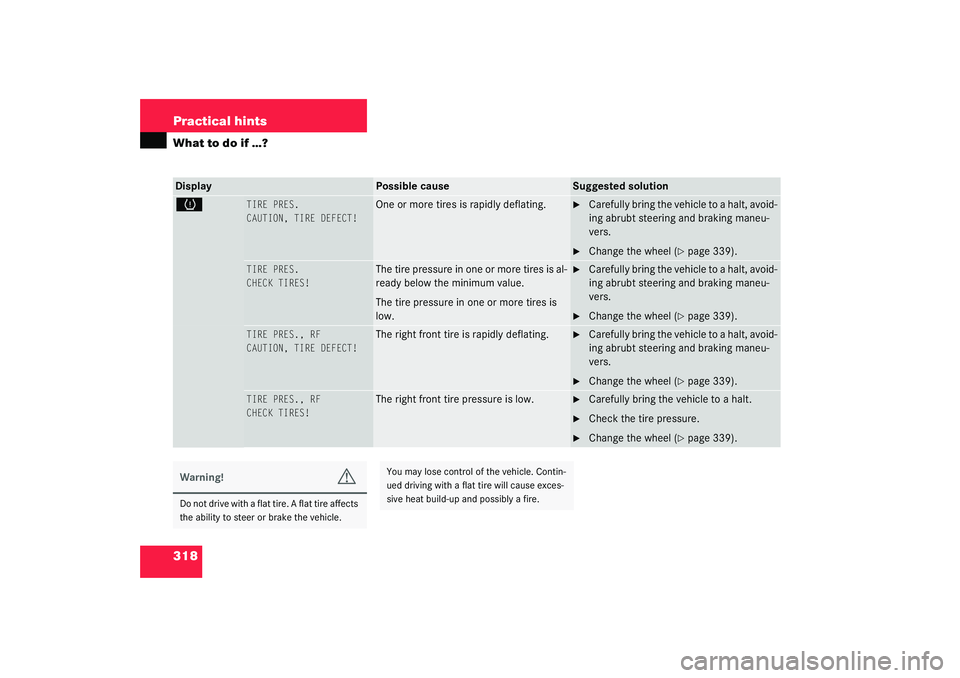
318 Practical hintsWhat to do if …?Display
Possible cause
Suggested solution
H
TIRE PRES.
CAUTION, TIRE DEFECT!
One or more tires is rapidly deflating.
�
Carefully bring the vehicle to a halt, avoid-
ing abrubt steering and braking maneu-
vers.
�
Change the wheel (
�page 339).
TIRE PRES.
CHECK TIRES!
The tire pressure in one or more tires is al-
ready below the minimum value.
The tire pressure in one or more tires is
low.
�
Carefully bring the vehicle to a halt, avoid-
ing abrubt steering and braking maneu-
vers.
�
Change the wheel (
�page 339).
TIRE PRES., RF
CAUTION, TIRE DEFECT!
The right front tire is rapidly deflating.
�
Carefully bring the vehicle to a halt, avoid-
ing abrubt steering and braking maneu-
vers.
�
Change the wheel (
�page 339).
TIRE PRES., RF
CHECK TIRES!
The right front tire pressure is low.
�
Carefully bring the vehicle to a halt.
�
Check the tire pressure.
�
Change the wheel (
�page 339).
Warning!
G
Do not drive with a flat tire. A flat tire affects
the ability to steer or brake the vehicle.
You may lose control of the vehicle. Contin-
ued driving with a flat tire will cause exces-
sive heat build-up and possibly a fire.
Page 319 of 416
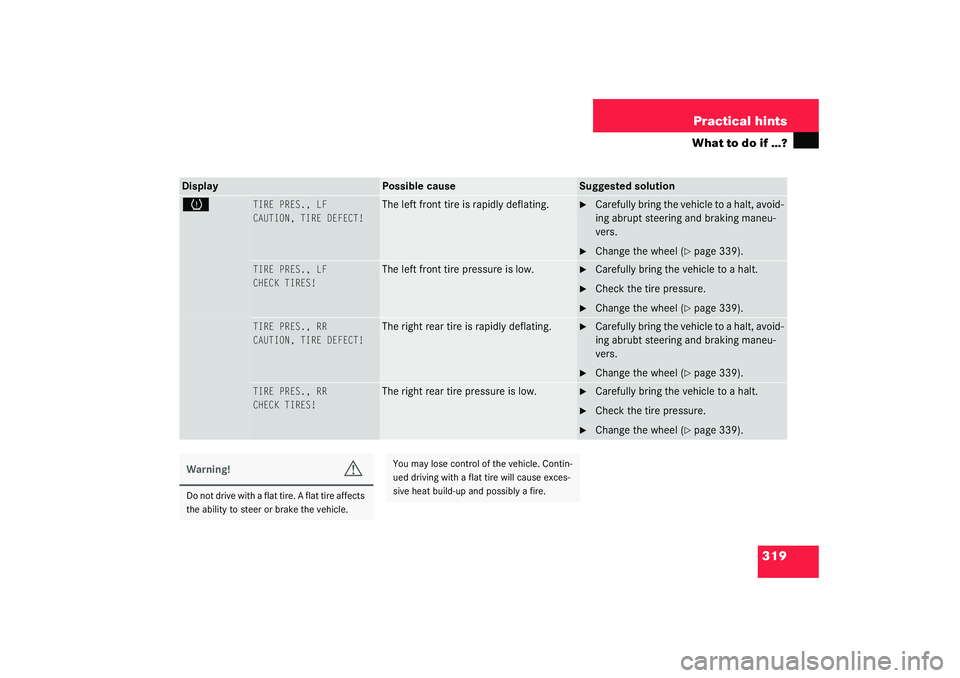
319 Practical hints
What to do if …?
Display
Possible cause
Suggested solution
H
TIRE PRES., LF
CAUTION, TIRE DEFECT!
The left front tire is rapidly deflating.
�
Carefully bring the vehicle to a halt, avoid-
ing abrupt steering and braking maneu-
vers.
�
Change the wheel (
�page 339).
TIRE PRES., LF
CHECK TIRES!
The left front tire pressure is low.
�
Carefully bring the vehicle to a halt.
�
Check the tire pressure.
�
Change the wheel (
�page 339).
TIRE PRES., RR
CAUTION, TIRE DEFECT!
The right rear tire is rapidly deflating.
�
Carefully bring the vehicle to a halt, avoid-
ing abrubt steering and braking maneu-
vers.
�
Change the wheel (
�page 339).
TIRE PRES., RR
CHECK TIRES!
The right rear tire pressure is low.
�
Carefully bring the vehicle to a halt.
�
Check the tire pressure.
�
Change the wheel (
�page 339).
Warning!
G
Do not drive with a flat tire. A flat tire affects
the ability to steer or brake the vehicle.
You may lose control of the vehicle. Contin-
ued driving with a flat tire will cause exces-
sive heat build-up and possibly a fire.
Page 320 of 416
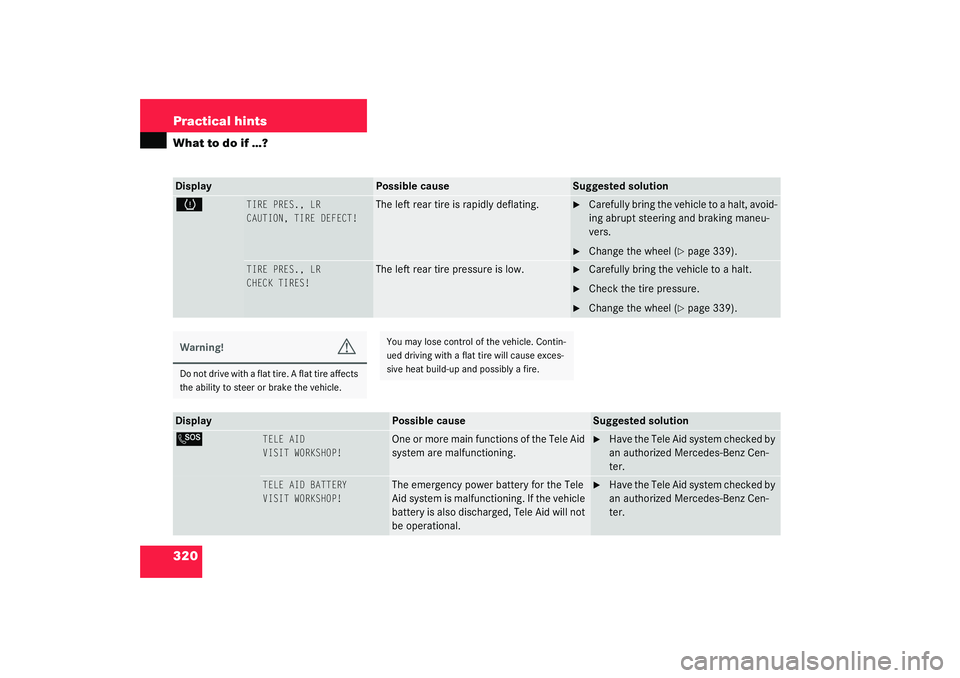
320 Practical hintsWhat to do if …?Display
Possible cause
Suggested solution
H
TIRE PRES., LR
CAUTION, TIRE DEFECT!
The left rear tire is rapidly deflating.
�
Carefully bring the vehicle to a halt, avoid-
ing abrupt steering and braking maneu-
vers.
�
Change the wheel (
�page 339).
TIRE PRES., LR
CHECK TIRES!
The left rear tire pressure is low.
�
Carefully bring the vehicle to a halt.
�
Check the tire pressure.
�
Change the wheel (
�page 339).
Warning!
G
Do not drive with a flat tire. A flat tire affects
the ability to steer or brake the vehicle.
You may lose control of the vehicle. Contin-
ued driving with a flat tire will cause exces-
sive heat build-up and possibly a fire.
Display
Possible cause
Suggested solution
L
TELE AID
VISIT WORKSHOP!
One or more main functions of the Tele Aid
system are malfunctioning.
�
Have the Tele Aid system checked by
an authorized Mercedes-Benz Cen-
ter.
TELE AID BATTERY
VISIT WORKSHOP!
The emergency power battery for the Tele
Aid system is malfunctioning. If the vehicle
battery is also discharged, Tele Aid will not
be operational.
�
Have the Tele Aid system checked by
an authorized Mercedes-Benz Cen-
ter.
Page 323 of 416
323 Practical hints
Where will I find ...?
The vehicle tool kit includes:�
One pair of universal pliers
�
Two open-end wrenches
�
One hex-socket wrench
�
One interchangeable slot/Phillips
screwdriver
�
One towing eye bolt
�
One wheel wrench
�
One alignment bolt
�
One fuse extractor
�
One fuse chart for the main fuse box
�
Spare fusesVehicle jack
To prepare the vehicle jack for use
�
Remove the vehicle jack from the spare
wheel well under the trunk floor.
�
Push the crank handle up.
�
Turn the crank handle clockwise until it
engages (operational position).Storing the vehicle jack in the trunk
�
Retract the vehicle jack arm to the
base of the vehicle jack.
�
Push the crank handle up.
�
Turn the crank handle counterclock-
wise to the end of the stop (storage po-
sition).
!To prevent damage, always disengage
trunk floor handle from trunk lid and
lower trunk floor before closing the
trunk lid.
Page 324 of 416
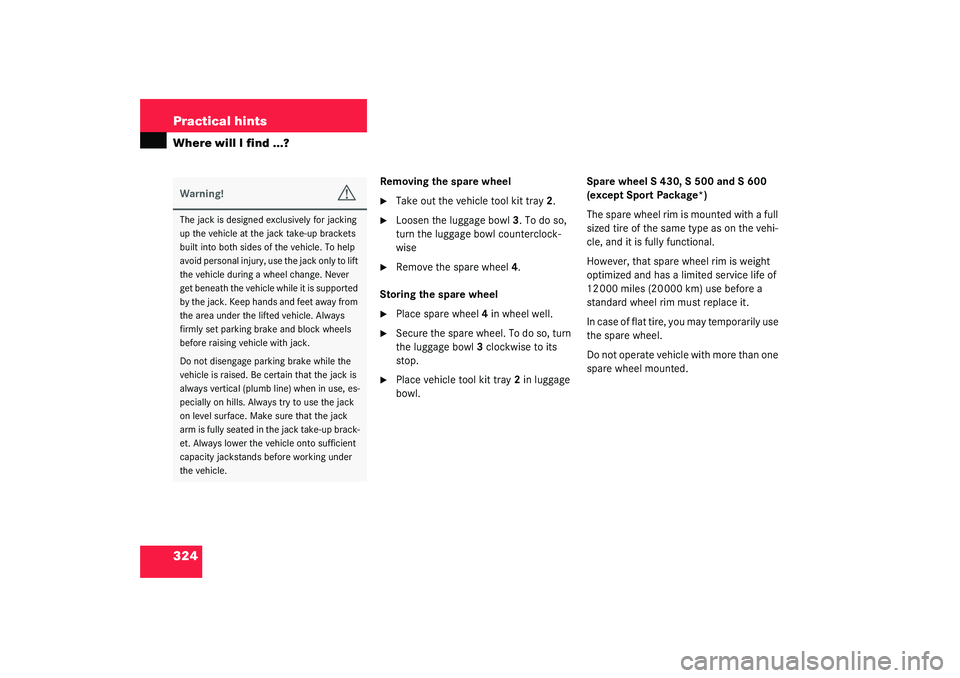
324 Practical hintsWhere will I find ...?
Removing the spare wheel�
Take out the vehicle tool kit tray2.
�
Loosen the luggage bowl3. To do so,
turn the luggage bowl counterclock-
wise
�
Remove the spare wheel4.
Storing the spare wheel
�
Place spare wheel4 in wheel well.
�
Secure the spare wheel. To do so, turn
the luggage bowl3 clockwise to its
stop.
�
Place vehicle tool kit tray2 in luggage
bowl.Spare wheel S 430, S 500 and S 600
(except Sport Package*)
The spare wheel rim is mounted with a full
sized tire of the same type as on the vehi-
cle, and it is fully functional.
However, that spare wheel rim is weight
optimized and has a limited service life of
12 000 miles (20 000 km) use before a
standard wheel rim must replace it.
In case of flat tire, you may temporarily use
the spare wheel.
Do not operate vehicle with more than one
spare wheel mounted.
Warning!
G
The jack is designed exclusively for jacking
up the vehicle at the jack take-up brackets
built into both sides of the vehicle. To help
avoid personal injury, use the jack only to lift
the vehicle during a wheel change. Never
get beneath the vehicle while it is supported
by the jack. Keep hands and feet away from
the area under the lifted vehicle. Always
firmly set parking brake and block wheels
before raising vehicle with jack.
Do not disengage parking brake while the
vehicle is raised. Be certain that the jack is
always vertical (plumb line) when in use, es-
pecially on hills. Always try to use the jack
on level surface. Make sure that the jack
arm is fully seated in the jack take-up brack-
et. Always lower the vehicle onto sufficient
capacity jackstands before working under
the vehicle.
Page 325 of 416
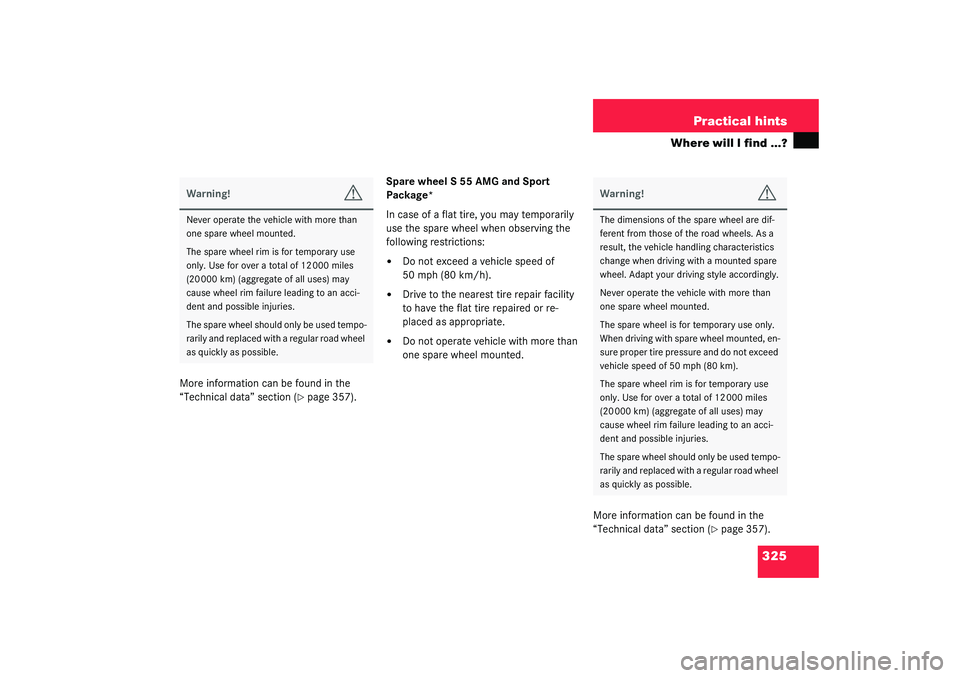
325 Practical hints
Where will I find ...?
More information can be found in the
“Technical data” section (
�page 357).Spare wheel S 55 AMG and Sport
Package*
In case of a flat tire, you may temporarily
use the spare wheel when observing the
following restrictions:
�
Do not exceed a vehicle speed of
50 mph (80 km/h).
�
Drive to the nearest tire repair facility
to have the flat tire repaired or re-
placed as appropriate.
�
Do not operate vehicle with more than
one spare wheel mounted.
More information can be found in the
“Technical data” section (
�page 357).
Warning!
G
Never operate the vehicle with more than
one spare wheel mounted.
The spare wheel rim is for temporary use
only. Use for over a total of 12 000 miles
(20 000 km) (aggregate of all uses) may
cause wheel rim failure leading to an acci-
dent and possible injuries.
The spare wheel should only be used tempo-
rarily and replaced with a regular road wheel
as quickly as possible.
Warning!
G
The dimensions of the spare wheel are dif-
ferent from those of the road wheels. As a
result, the vehicle handling characteristics
change when driving with a mounted spare
wheel. Adapt your driving style accordingly.
Never operate the vehicle with more than
one spare wheel mounted.
The spare wheel is for temporary use only.
When driving with spare wheel mounted, en-
sure proper tire pressure and do not exceed
vehicle speed of 50 mph (80 km).
The spare wheel rim is for temporary use
only. Use for over a total of 12 000 miles
(20 000 km) (aggregate of all uses) may
cause wheel rim failure leading to an acci-
dent and possible injuries.
The spare wheel should only be used tempo-
rarily and replaced with a regular road wheel
as quickly as possible.